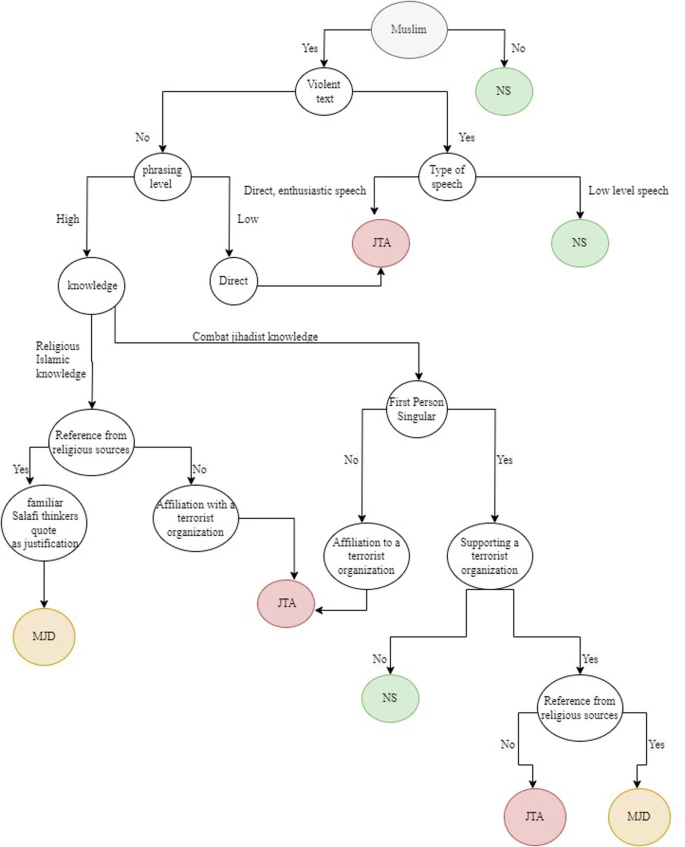Terrorist groups have shifted their communications to the Darknet, to evade detection by law enforcement. These groups use online “influencers” – people who can persuade others to join or support their cause. This study took a closer look at these influencers, specifically focusing on a type of religious preaching called Da’wa, which traditionally calls people to Islam peacefully. However, some extremists have twisted it to encourage violence instead.
Key Insights
- Terrorist groups increasingly use the Darknet to avoid detection, capitalizing on its encrypted and anonymous structure for secure communication and recruitment activities.
- The research analyzed over 6,000 posts from Darknet forums between 2017 and 2018.
- Two extremist influencers stand out: Militant Jihadist Da’wa (MJD) and Jihadist Terror Activists (JTA).MJD influencers use high-register Arabic and religious texts to make violence appear religiously justified. This has increased alongside the current Isreal-Palestine conflict
- Researchers used the Reciprocal Human-Machine Learning (RHML) model to analyze messaging patterns.
The research analyzed over 6,000 posts from Darknet forums used by Jihadist groups from 2017 to 2018, exploring how these influencers use religious messages to incite violence. Researchers used a new technique called Reciprocal Human-Machine Learning (RHML), where human experts and AI work together to detect these hidden, dangerous messages.
Understanding Da’wa: From Peaceful to Violent Messaging
The word Da’wa means “to call” and traditionally refers to inviting people to Islam. It has always been a peaceful call to faith. Over the years, though, some extremists have changed the message of Da’wa to encourage violence. Today, extremist Da’wa influencers hide in the Darknet, which allows them to avoid being seen by regular social media platforms and evade law enforcement. By using high-register Arabic (a formal language style) and referencing religious texts, these influencers try to make violent acts seem justified in the name of religion.
The researchers focused on two groups within these forums:
- Militant Jihadist Da’wa (MJD): Those who use Da’wa to encourage violence and incite terrorist actions.
- Jihadist Terror Activists (JTA): People who directly promote or engage in violence.
How Terrorist Influencers Operate on the Darknet
The study revealed that Militant Jihadist Da’wa (MJD) influencers on the Darknet use specific language styles and structures to make their messages seem credible and legitimate. These influencers selectively quote religious texts, like the Quran and Hadith, often taking them out of context to justify violent actions as religious duties. Unlike more casual Jihadist content, MJD messages use highly formal Arabic and carefully structured arguments to appeal to those who respect religious authority. This formal tone and academic style help MJD influencers present their messages as serious religious teachings, making their calls for violence appear justified in the eyes of followers. They act like teachers, crafting persuasive “lessons” that guide readers toward extremist beliefs rather than just informing them of current events.
Unlike Jihadist Terror Activists (JTA), who often discuss recent battle events and use straightforward, conversational Arabic, MJD influencers carefully construct arguments to subtly encourage violent action under the guise of religious duty. By focusing on complex language and religious citations, they create a sense of authority, leading followers to believe that militant actions align with Islamic teachings. For counterterrorism teams, understanding this approach is critical, as it highlights how MJD influencers recruit by blending religious context with extremist ideas.
The Use of AI and the RHML Model
To detect extremist messages on the Darknet, researchers developed a new approach called Reciprocal Human-Machine Learning (RHML), where human experts and AI work together in a continuous learning loop. This collaboration is essential because Darknet messages often use complex and formal Arabic with religious references, making it hard for AI alone to reliably identify extremist content. By using the RHML approach, researchers combine human expertise, which is needed to understand religious and cultural context, with AI’s ability to process large amounts of data quickly.

The RHML model operates in several stages, allowing AI and human experts to improve each other’s effectiveness. First, experts identify specific traits of extremist messages, such as unique language patterns or specific religious citations. The AI then tags messages based on these patterns, producing initial results. Human experts review these results, giving feedback to fine-tune the AI’s criteria. This process repeats until the AI model reaches high accuracy, capable of distinguishing Militant Jihadist Da’wa (MJD) messages from regular posts more reliably.
A key part of RHML is its adaptability: the AI learns from each expert adjustment, making it better equipped to handle new patterns of extremist messaging as they evolve. This ongoing interaction between human insight and machine learning is vital for staying up-to-date with the ever-changing tactics of extremist groups on the Darknet. Through RHML, the research team created a more powerful and flexible system, where AI can detect hidden extremist content while continuously adapting based on human feedback.
Challenges in Detecting Extremist Content on the Darknet
Detecting this type of extremist content is challenging, especially as MJD influencers operate in hidden, encrypted Darknet forums, such as Dread, which are difficult to monitor. The ongoing Israel-Palestine conflict has intensified the use of extremist messaging on the Darknet, as various groups aim to capitalize on the heightened emotions and divisions it has caused globally. In particular, groups such as Hezbollah, ISIS, and al-Qaeda are reportedly encouraging violent acts against Jewish communities and supporters of Israel worldwide. This uptick in incitement is observed not only in the Middle East but also within the United States, where extremist organizations have issued specific calls for attacks, leveraging online channels that evade conventional monitoring, such as encrypted Darknet forums and closed social media networks.
Due to the fact that they also use complex, formal Arabic and religious language, making it hard for automated systems to distinguish between peaceful religious discussion and content meant to incite violence. Since MJD messages often include direct references to respected religious texts, they appear legitimate, which can mask extremist intent.
To address this challenge, researchers had to teach the AI model to identify these specific language cues, allowing it to spot formal Arabic phrases, religious references, and structured arguments typical of MJD messages. By training the AI with human expert insights, researchers improved the model’s ability to recognize subtle differences between standard posts and MJD posts, making it more effective in detecting extremist messages hidden on the dark net.
How This Study Can Help Future Efforts
This study provides two important contributions to counterterrorism efforts. First, it broadens the focus beyond terrorists who directly carry out violent acts to include those who use their influence to inspire or recruit others into extremism. By analyzing both Militant Jihadist Da’wa (MJD) influencers and Jihadist Terror Activists (JTA), the study highlights the importance of identifying not only active threats but also those who lay the groundwork for radicalization, making counterterrorism strategies more comprehensive.
This ongoing conflict underscores the need for adaptive counterterrorism approaches as groups use the war’s narrative to foster global support for their ideologies and recruit operatives for localized attacks
The second major contribution is the development of the Reciprocal Human-Machine Learning (RHML) model, which enables AI and human experts to work together and adapt to changes in how extremist content is communicated. This approach shows that combining human insight with advanced AI can lead to a better understanding and detection of terrorist influencers, even as they shift their methods across online platforms. Future studies could expand this model to monitor more digital spaces in real-time, helping keep counterterrorism efforts one step ahead in identifying and combating extremist messaging online.

